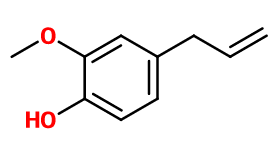Eugenol
Naturelle - Synthétique
Spicy > Warm Spices > Eugenolic

Crédits photo: ScenTree SAS
Other names :
2-methoxy-4-prop-2-enylphenol ; 4-allyl catechol-2-methyl ether ; 4-allyl guaiacol ; 4-allyl-1-hydroxy-2-methoxybenzene ; 1-hydroxy-2-methoxy-4-allyl benzene ; 1-hydroxy-2-methoxy-4-propenyl benzene ; 4-hydroxy-3-methoxy-1-allyl benzene ; 2-hydroxy-5-allylanisole ; 2-methoxy-4-(2-propen-1-yl)phenol ; 2-methoxy-4-allylphenol ; 2-methoxy-4-prop-2-enylphenol ; 2-methoxy-4,2-propen-1-ylphenol
Volatility :
Head/Heart
Uses in perfumery :
Eugenol is used in ambery, vanillic, carnation, rose and spicy notes. Brings a spicy and vanillic touch to floral notes.
Natural availability :
Eugenol is present up to more than 90% in Clove Bud EO and in Cinnamon Leaf EO. These raw materials enable an easy extraction of Eugenol in its natural state.
Year of discovery :
Data not available.
Other comments :
Eugenol is one of the 26 allergens in perfumery.
Price Range :
€€
Stability :
Becomes red under the effect of light. This raw material is not convenient in every functional base : can't be used in a candle or shower gel base.

Crédits photo: ScenTree SAS
- Molecular formula :
- C10H12O2
- Molecular Weight :
- 164,2 g/mol
- Density :
- 1,066
- Flash Point :
- 112°C
- Fusion Point :
- -11°C
- Appearance :
- Pinkish liquid
- Log P :
- 2,7
- Boiling Point :
- 253°C
- Detection Threshold :
- Entre 6 et 100 ppb (0,00001%) selon les personnes,
Synthesis route :
Eugenol is often obtained by distilling natural raw materials. The essential oils (mainly Clove Bud EO) are placed in an alkaline medium, to isolate the non-phenolic compounds by distillation. After acidifying the medium at low temperature, Eugenol can be obtained by distillation too.
Synthesis precursor :
Eugenol is a precursor to the synthesis of several compounds of olfactory interest. First of all, it allows to synthesize DihydroEugenol by catalytic hydrogenation. Isoeugenol can be synthesized from its isomer. Finally, an esterification or etherification of the alcohol function allows to obtain various compounds of interest.
Isomerism :
Isoeugenol is an isomer of Eugenol, as the double bond present on the two molecules is simply relocated from one molecule to another. However, its smell is fruity and less woody and vanillic. In addition, ortho and meta-Eugenol exist but are very little used in perfumery. For example, the smell of meta-Eugenol is quite similar to Eugenol, and has a strong aspect of carnation.
Frambinone® and Styrallyl acetate are also constitutional isomers of Eugenol although they have a very different smell: fruity-raspberry for one, and rhubarb for the other.
- EINECS number :
- 202-589-1
- FEMA number :
- 2467
- JECFA number :
- 1529
- FLAVIS number :
- 04.003
- Allergens :
- Eugenol may provoke an allergic reaction on skin contact (redness, heat, scraching, prickling) for some people.
- IFRA :
- This ingredient is restricted by IFRA
- Restriction type :
- RESTRICTION
- Cause of restriction :
- DERMAL SENSITIZATION AND SYSTEMIC TOXICITY
- Amendment :
- 49
- Quantitative limit on the use :
-
Cat.1 Cat.2 Cat.3 Cat.4 Cat.5A Cat.5B Cat.5C Cat.5D Cat.6 0,45 % 0,14 % 1,4 % 2,5 % 0,64 % 0,64 % 0,64 % 0,21 % 0,64 % Cat.7A Cat.7B Cat.8 Cat.9 Cat.10A Cat.10B Cat.11A Cat.11B Cat.12 1,4 % 1,4 % 0,21 % 4,9 % 4,9 % 18 % 0,21 % 0,21 % No Restriction - Restriction type :
- RESTRICTION QRA
- Cause of restriction :
- SENSITIZATION
- Amendment :
- 43
- Quantitative usage limits :
-
Cat.1 Cat.2 Cat.3 Cat.4 Cat.5 Cat.6 Cat.7 Cat.8 Cat.9 Cat.10 Cat.11 0,2 % 0,2 % 0,5 % 0,5 % 0,5 % 4,3 % 0,4 % 0,5 % 0,5 % 0,5 % Not Restricted
To learn more about IFRA's standards : https://ifrafragrance.org/safe-use/library
ScenTree is solely responsible for the information provided here.


